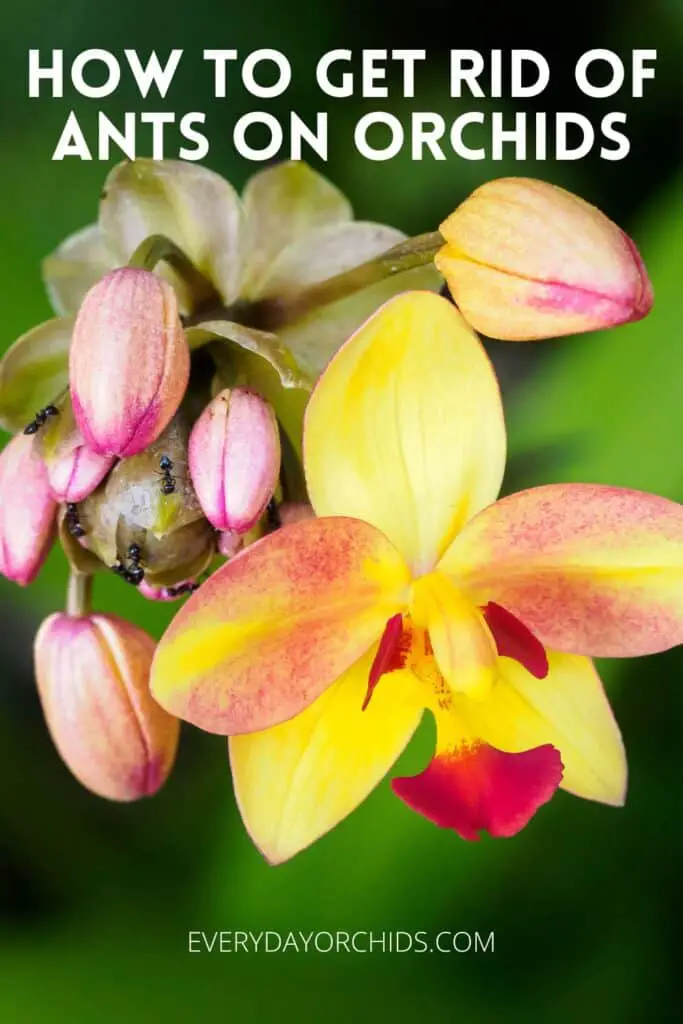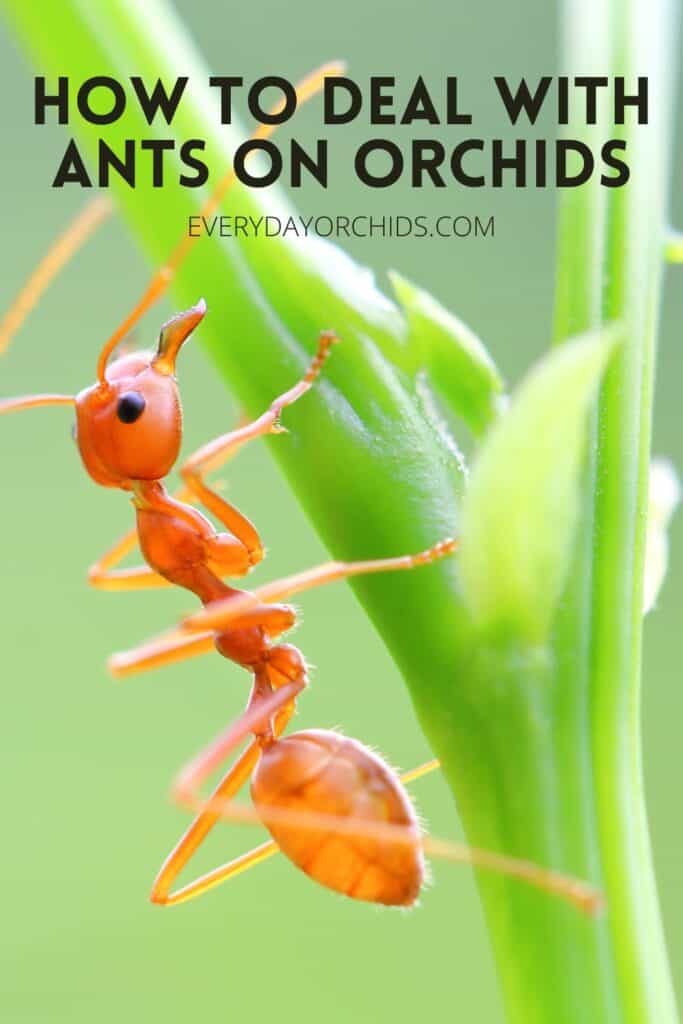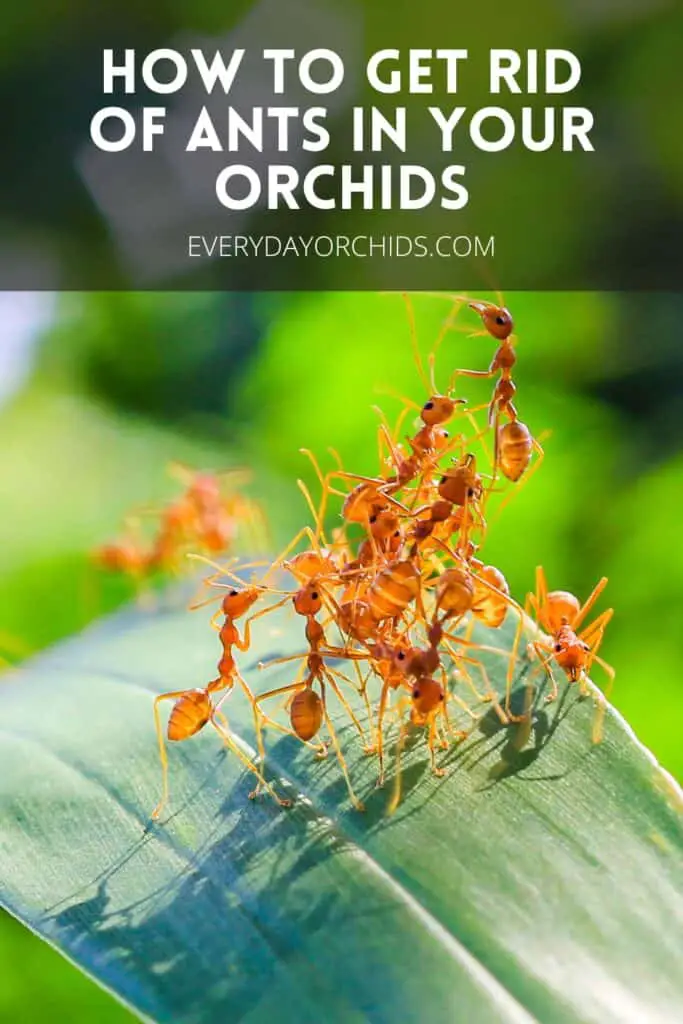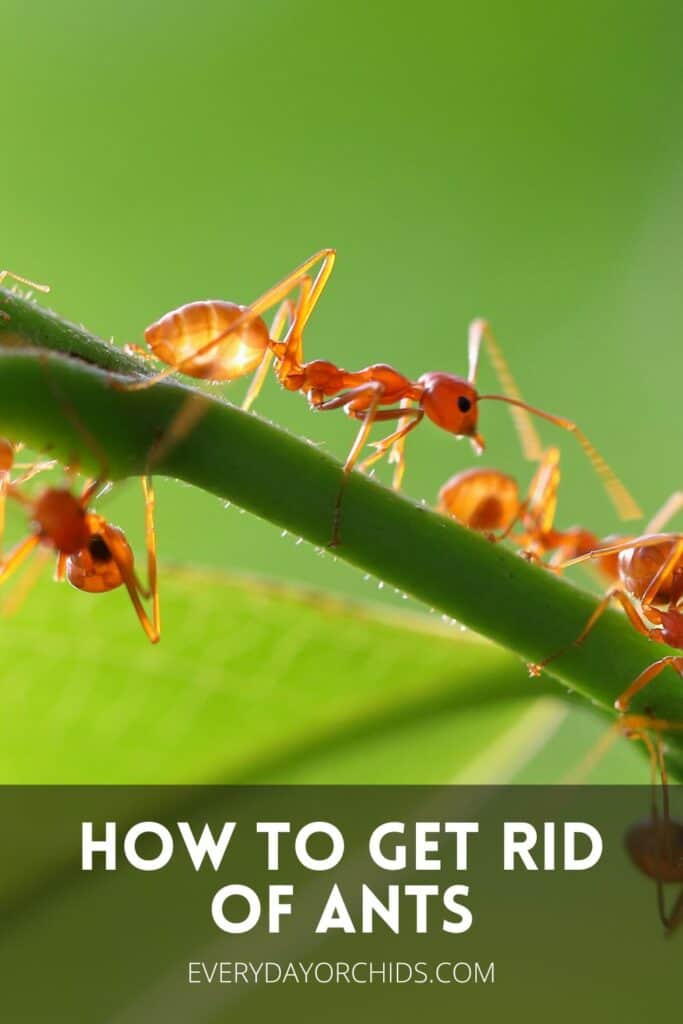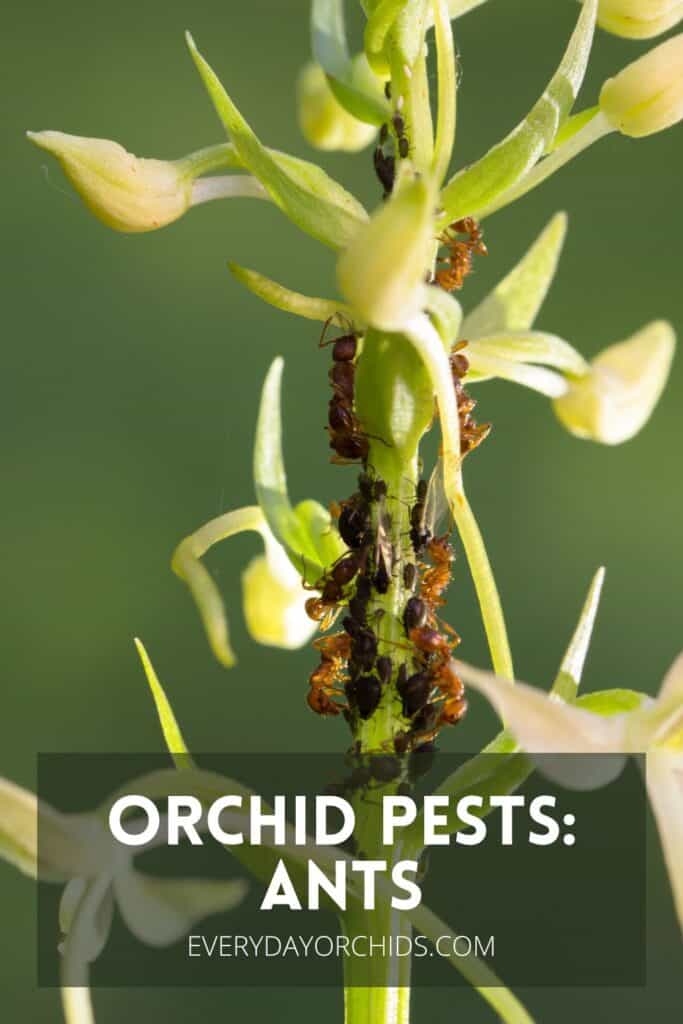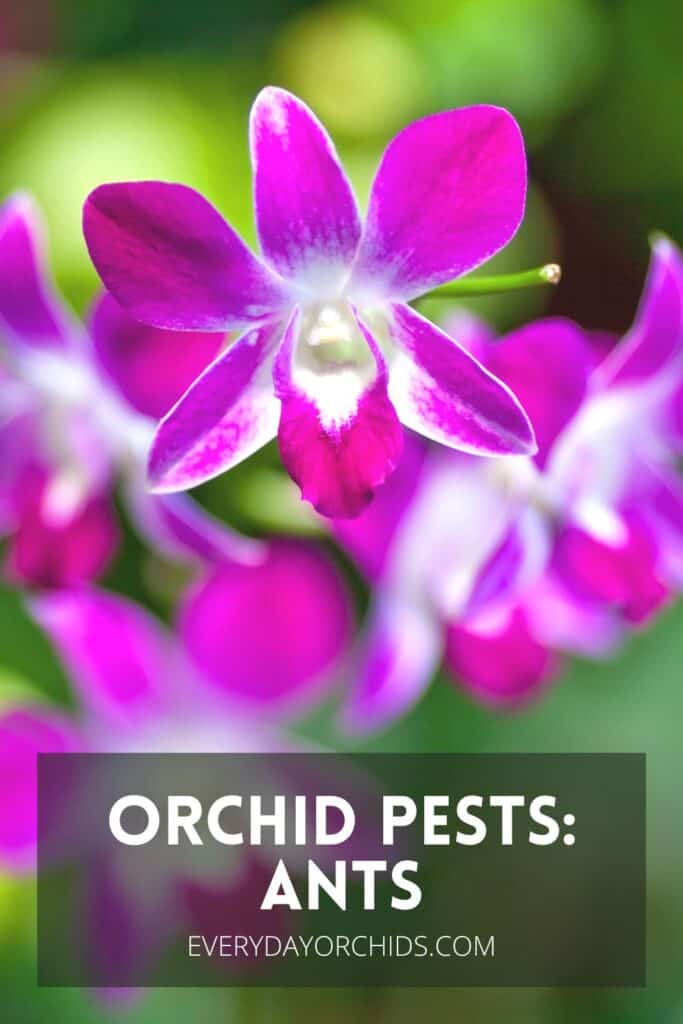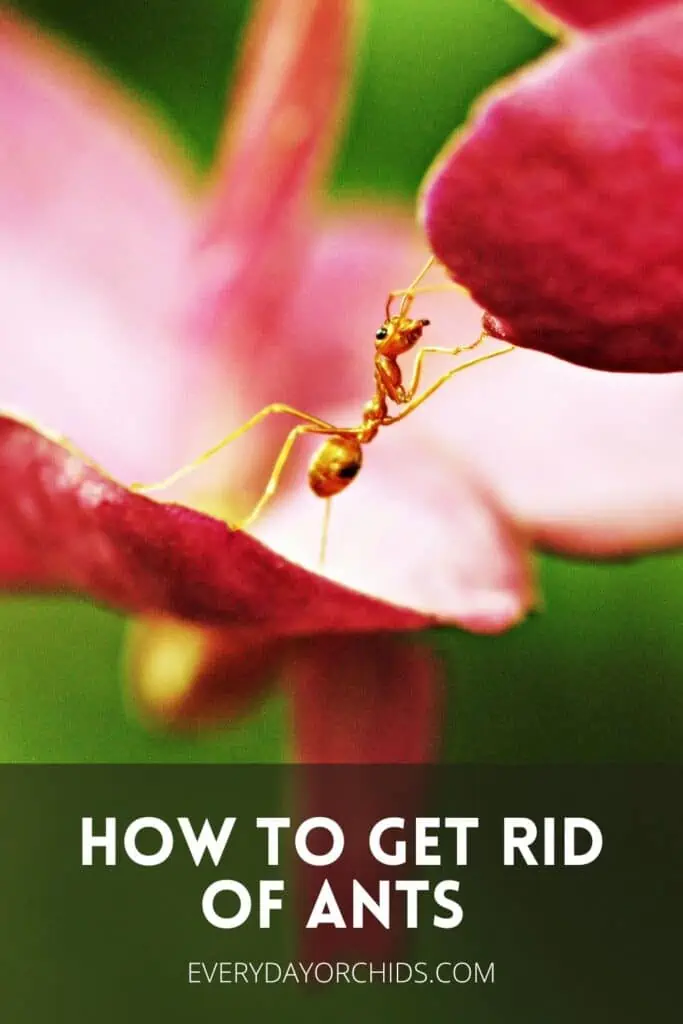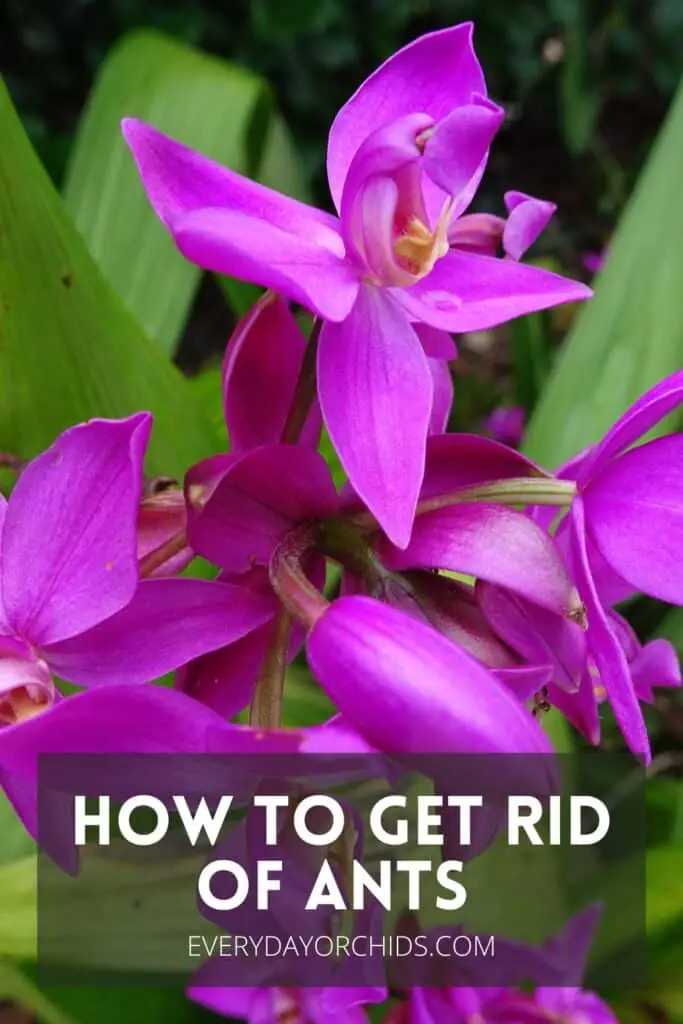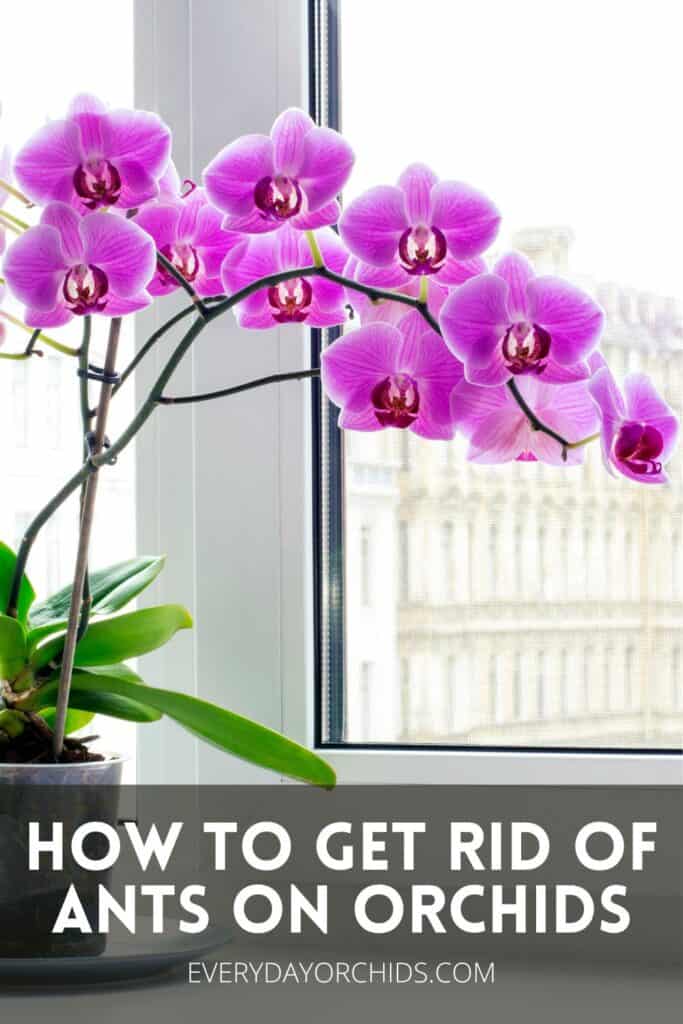If you see ants on your orchids, take note. Ants on orchids are not very common, but when you see a line of ants going in and around your orchids, it’s a sign that something bigger is going on.
Ants can indicate the presence of aphids, scale or mealybugs on your orchids. There may also be an ant colony hidden in your orchid pot. When you see ants on your orchids, you’ll need to do some investigating and then address the main problem.

While finding ants on orchids is not very common for most orchid growers, it does happen. Many orchid growers keep their orchids indoors and may never encounter ants on their orchids. But for those of us who grow orchids outdoors or keep them in a greenhouse for any part of the year, finding ants in and around our orchids is not unheard of.
In this article, I’ll go over the top reasons why you may find ants on orchids and what to do about it. You’ll learn how to get rid of ants that are in and around your orchids. I’ll also talk about how to keep ants from coming back. Keep reading to learn more.
Please note that these links are affiliate links and as an Amazon Associate, I earn from qualifying purchases. Purchases made through affiliate links in this post may generate commissions at no additional cost to you. Use this link for a discounted Amazon Prime trial. Thank you for your support!
Table of Contents
Why Do I Have Ants On My Orchids?
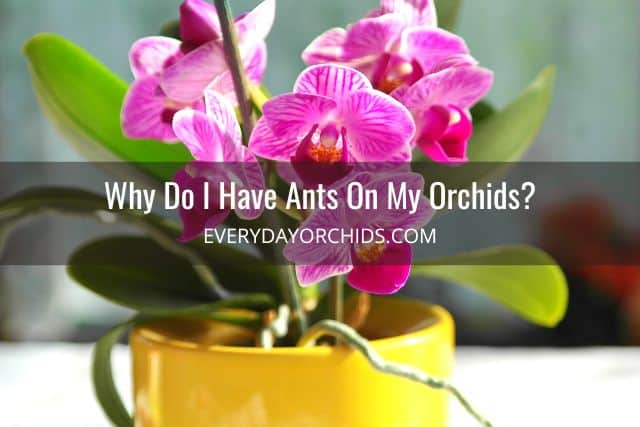
Ants are not naturally attracted to orchids, so if you see ants in your plants, there is generally a good reason. They are usually present because they are attracted to a clear, sweet sap on the orchid. This sticky sap is also called honeydew. It is produced by both orchid pests and a happy orchid.
So, first things first, figure out why ants are coming to your orchids. Does your orchid only have small droplets of honeydew on the leaves? Or can you spot both honeydew and other orchid pests?
Some orchid pests, such as aphids, scale and mealybugs, can produce honeydew. Ants eat this honeydew and it is a great food source for them. Ants will even go to some lengths such as farm aphids to keep production of honeydew flowing. In addition to eating the honeydew, ants will also eat the aphid larvae.
Other times, small droplets of honeydew on the orchid can be a sign of a healthy, happy orchid. Some orchid species produce honeydew on their leaves and near their flower buds. Phalaenopsis orchids do this to some degree, as do Cymbidium and Cattleya orchids. The problem is, ants are attracted to this clear, sweet, sticky sap. Left to their own devices, you may end up with a swarm of ants on your orchid.
Can Ants Harm Orchids?
No, ants do not harm orchids like other orchid pests would. However, this doesn’t mean that you can ignore them. The mere presence of ants on your orchids could be a signal that other orchid pests, such as aphids, scale and mealybugs, are present. In many cases, this is more likely than not.
Remember how ants are able to farm aphids? Well, if left alone, ants will encourage the aphid population to grow. In just a few short weeks, your orchids could be covered in both aphids and ants.
This is why you’ll need to investigate further to find out what other pests may be hiding in your orchids. Then, identify that pest and take steps to get rid of them. I’ll go into that in more detail later.
Another reason why you don’t want to ignore ants on orchids is sooty mold. The accumulation of honeydew on the orchid can result in fungal infections such as sooty mold. This is a black fungal infection that can damage plants and weaken your orchids over time.
So while ants don’t outright harm orchids, you don’t want to ignore them either. You also need to consider the damage that aphids, mealybugs or scale are inflicting onto your orchid. Once you see ants on your orchids, you’ll want to act quickly to contain and address the problem.
How Do I Get Rid Of Ants On My Orchids?
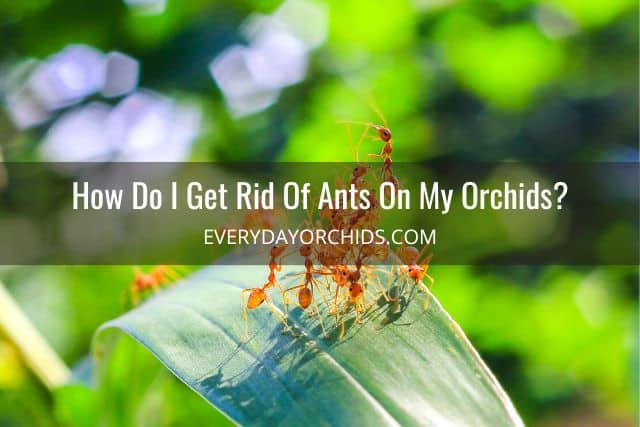
Ants generally do not respond to the usual orchid pest control treatments. Rubbing alcohol, horticultural oils, insecticidal soap sprays may be great and very effective for orchid pests, but not for ants. Here are some steps you’ll need to take to address the ant problem.
Start With The Ant Trail
To deal with the ant problem on your orchids, you’ll first need to reduce the number of ants moving towards your orchid or around your orchid.
Whether your orchids are indoors or outdoors, in both cases, you’ll be able to see an ant trail. You’ll need to first stop the onslaught of ants coming to your orchids. Deal with the ants first before you try to get rid of the aphids, mealybugs or scale. Ants will try to protect the smaller orchid pests as that is their food source.
For starters, look to see where ants are coming from. If your orchids are indoors and the ants are coming from outdoors through a hole or crack in the wall, block that access point. If your orchids are outdoors, determine where the larger ant colony is located.
Set Out Ant Traps
Lay out some ant traps along the ant trail. Some of the ants will enter the trap and take the bait. They will then return back to their colony with the bait, poisoning the rest of the ants and killing them off.
Use the type of ant bait that will kill the queen. Otherwise, she will just produce more ants. In addition to laying out ant traps along the trail, feel free to place some next to your orchid pots or on top of the orchid potting media if you have a bad infestation.
Here are some suggested products that are very effective:
- Terro Ant Bait Stations: Place these bait traps anywhere you see a cluster of ants and along the ant trail. Worker ants will bring the poisonous bait back to the colony, killing off many more ants. It may take a few days to see significant results, but it works.
- Harris Ant Killer: This works similar to Terro Ant Bait. The sweet substance in the traps attracts ants and they bring the poison back to the colony. It contains borax, which is a natural ant killer.
Eliminate The Ant Trail
Once you’ve ensured that the larger ant colony has been dealt with, you are ready to address the trail leading from the ant colony to your orchids. Simply rinsing the area down with water will not be enough to disrupt the scent. Instead, you will need to use one of several methods below to erase the ant trail.
Vinegar Spray
Pour some white vinegar into a spray bottle. Liberally spray down the trail area, starting from the edges of the orchid pots to the colony. White vinegar has a very strong smell, so I would caution against doing this indoors. Save this method for outdoor orchids and other plants infested with ants.
Before you begin, make sure it is safe to spray the ground with vinegar. Some surfaces, such as limestone, can’t handle the acidity of vinegar and would be damaged by a vinegar spray.
Steam Mop
For indoor ant problems, I recommend spraying down the ant trail with an insecticide ant spray like Raid, then steam mopping the area.
This is the technique I use for indoor ants. I’ve found it to be pretty effective in disrupting the flow of ants. Simply wiping down the floor or walls with a damp cloth isn’t enough to eliminate the ant trail.
The heat and water of the steam mop, along with an insecticide ant spray, however, is a good combination. The spray kills the ants present while the hot steam helps break down the pheromones laid down by the ants. It erases the trail and cleans up any residual insecticide spray left on the floor.
Ground Cinnamon
If you’ve read my articles about crown rot or stem rot, then you’ve probably used ground cinnamon powder on your orchids. However, believe it or not, ground cinnamon can also be used for pest control.
Sprinkling ground cinnamon powder along and around the ant trail is a quick and inexpensive way to erase an ant trail.
Ants don’t like the smell of cinnamon and this deters them. Use a generous amount of ground cinnamon when covering the ant trail.
Sidewalk Chalk
Sidewalk chalk is another easy and cheap method for dealing with ants. You can use chalkboard chalk or sidewalk chalk for this. Ants, for whatever reason, are repelled by chalk.
To use this method, simply take a piece of chalk and draw a line directly over the ant trail.
The chalk covers up the pheromones and scent laid down by the scout ants. Subsequent ants will not be able to pick up the trail and you’ll have less ants coming to your orchids.
Diatomaceous Earth
Diatomaceous earth is used to deal with bed bugs, roaches, ants and other pests. It is a form of silicone powder that is fairly inexpensive. It works by cutting into the ant’s exoskeleton, almost as if the ant had walked on shards of glass, and causes death by dehydration.
There are two types you can buy: pool-grade and food-grade. Buy the food-grade diatomaceous earth. This is the one I bought for our home’s pest problems. The nice thing is that it comes with a powder duster, making it easier to spread the powder along baseboards and other surfaces.
Note: Do not use diatomaceous earth if you have pets or young children or if you have severe respiratory issues. When I used this to deal with a pest problem, it triggered breathing problems for me. I had to wear an N-95 and even then, I did get short of breath. So, user beware.
Also, I’ve used diatomaceous earth indoors, but only in a less-trafficked room for which I could close the door. I would suggest the same for you. For my orchids in more trafficked areas, like my living room, I opted for one of the other ant removal methods.
In general, I would recommend using this outdoors or in a section of your house that you can seal off. When applying this or when cleaning it up, always wear gloves and an N-95 respiratory mask.
To use diatomaceous earth, simply sprinkle the powder along the ant trail.
If you are indoors and dealing with a heavy ant and pest infestation, you may even want to sprinkle it along the baseboards, window sills, and other points of entry.
Diatomaceous earth doesn’t work immediately. It can take up to a day for it to kill the ants. If you need immediate results, use an insecticide spray instead.
Insecticide Spray
As mentioned above, for indoor ant problems, I usually spray the ant trail down with a layer of insecticide spray and let it dry. This kills off the ants along the trail. Then I follow up with steam mopping the entire area so that the ant trail gets erased. This way, their ant buddies won’t be able to make their way to my orchids or other plants again.
When using insecticide spray, do this in a well-ventilated room and continue to air out the room for a time afterward. Keep small children and pets away.
Only spray the ant trail leading up to the plant pots, but do not spray the pots or plants themselves.
If you plan to spray down your orchid plants because of a severe pest problem, be sure you use an orchid safe insecticide spray. I would recommend these orchid-safe products:
- Orange Guard: I mentioned Orange Guard in my article about aphid treatment. It is also effective against ants, aphids and spider mites. Orange Guard is an organic, biodegradable pesticide made out of orange peels. It is safe to use indoors, around children and pets.
- Mighty Mint Insect And Pest Control: This is another all-natural pest deterrent. It is made from peppermint and repels pests in the same way that cinnamon powder, garlic cloves and other strong-odored repellents would.
The Terro Ant Bait I recommended in the earlier section also comes in a spray version called Terro Ant Spray. If you want to use this product, just know that, while it is very effective at killing ants, it is not safe for use on plants. Only spray it on the areas around your orchids, but not on your orchids themselves.
Rinse The Orchid
Once you’ve addressed the ant trail and stopped the onslaught of ants arriving at your orchids, you are ready to deal with the ants actually on the orchids.
First, take your orchid outdoors if you haven’t already. Then, using a strong spray of water, spray down your orchid to wash off as many ants and other pests as possible. Try to spray off the undersides of orchid leaves and areas where you see a number of ants or other pests.
Do this in the morning and leave your orchids in a shaded, protected area to dry off. Be sure to remove any water from the orchid crown and leaf joints. This will reduce the risk for crown rot and stem rot.
Remove The Honeydew
Also, after you’ve rinsed off your orchid and while you are starting the targeted pest treatment, look for areas of honeydew.
Honeydew is that clear, sweet, sticky sap produced by bugs and orchids. Ants are attracted to this. This may be found on the underside of orchid leaves or near the flower buds.
Take a warm, damp cloth and gently wipe off the honeydew. Cleaning this off of the orchid will remove some of the attractant.
Eliminate Aphids, Mealybugs And Scale On Orchids
Once that’s done, you’ll also need to deal with the underlying pest problem. Do a thorough inspection and determine if your orchid is infested with aphids, mealybugs or scale.
Focus on a few spots in particular. Key areas you’ll want to check include the underside of the orchid leaves, the leaf joints where the leaf meets the main stem, areas of young or new growth, and around the flower buds. These are typically the places where orchid pests like to hide.
Mealybugs look like oval-shaped white fuzz on the plant. Scale appear as white, brown or tan oval or circular-shaped discs on orchids. Last, but not least, aphids are light-green or brown pear-shaped insects that are just a few millimeters long.
Once you’ve identified the particular pest attracting ants to your orchid, use the guides below to address the problem. In these Everyday Orchids guides, you’ll find a variety of treatment options, as well as suggestions on how to prevent these pests from returning in the future.
- How To Get Rid Of Aphids On Orchids
- How To Get Rid of Scale On Your Orchid
- Mealybug Identification And Treatment
Whatever pest control option you use, multiple rounds of treatment will likely be necessary. The presence of ants generally indicates a well-established pest colony.
Most pest treatments mainly target the adult pests, so you’ll need to repeat treatments weekly to get all the pests over the various life cycles. This will ensure that you get any young aphids, scale or mealybugs that were missed on earlier rounds.
Repot Your Orchid
I will talk about this in more detail below, but repotting your orchid is a great treatment method for both getting rid of ants and preventing them from coming back.
Also, if you don’t want to use any harsh chemicals, poisons or insecticides, repotting your orchid is the way to go. You’ll need to use a clean new pot and new orchid potting media. It takes more work, but it can be worth your time.
How To Prevent Ants From Coming Back To Your Orchids
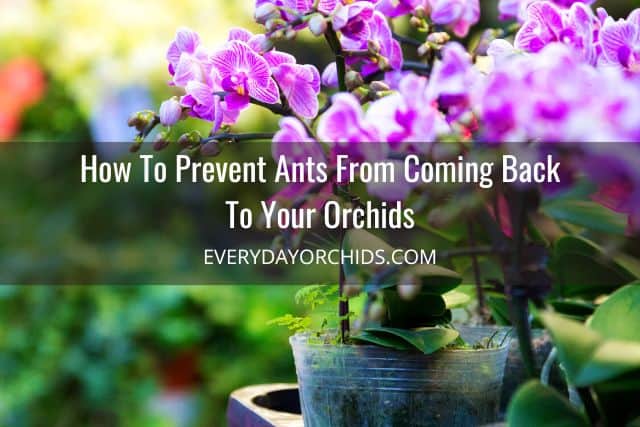
In addition to dealing with the ants and other orchid pests on your orchid, you’ll want to take steps to prevent them from coming back.
Clean The Pots
At minimum, clean the outside of your orchid pots. Depending on the type of pot you have, you may be able to use warm water and a mild detergent to clean the outside of the pots. This will remove the pheromones the ants have left behind.
Repot The Orchid
For serious ant infestations, it may be necessary to repot the orchid and start over with a clean pot and fresh potting media. In many cases, this intervention will get rid of the ants and prevent them from coming back.
The reason for this is that pests lay eggs in the potting media. Ant and other pest eggs may be hiding in the old potting media and pot. In severe infestations, there may even be an ant nest forming in your orchid’s potting media.
Ant nests in orchid potting media reduces the airflow between the orchid bark and roots, hastens degradation of the potting media, and can contribute to root rot and root death. If you think there’s a chance that there’s an ant nest forming in your orchid pot, you will need to change it all out immediately.
If any pest eggs or nests are present in the potting media, your orchid will continue to suffer from repeated infestations. Remember, as long as the ant queen lives, she will continue to lay eggs and produce more ants. Not long is this prolonged infestation stressful and damaging to your orchid, but it also increases the amount of work for you.
Use New Orchid Potting Media
Repotting your orchid into fresh orchid bark helps address the problem of pests and eggs hiding in the potting media. Similar to when you have an orchid with root rot, you want to bag up and throw away all the old potting media.
Before placing your orchid in the new potting media, carefully and thoroughly clean the orchid roots. Remove any old potting media that may be clinging to the roots.
I usually like to set my orchid roots in a 5-gallon bucket of water and gently work away the old potting media. Thoroughly cleaning the orchid’s roots in water helps remove any pest eggs or pests that may have been hiding and removes all traces of the old potting media.
Here are some additional resources for you:
- How to repot an orchid.
- How to choose an orchid potting media.
- The difference between using bark and sphagnum moss to pot orchids.
Use A Clean, Sterilized Orchid Pot
As for the orchid pot, use a new, sterilized orchid pot. If you don’t have one, you can use the old orchid pot, but with some caveats.
After removing your orchid from the pot, thoroughly wash and clean the dirt and visible residue from inside and outside the pot.
Then sterilize it using one of the methods outlined in my orchid pot article, either with the oven method or soaking the pot in a diluted bleach solution. Depending on the type of material your orchid pot is made of, and how large it is, cleaning it with boiling water is another option.
Don’t skip this sterilization step! Sterilizing the pot ensures that all the pests and their eggs are killed. This is especially important if you ever want to reuse the orchid pot.
Regularly Inspect Your Orchids For Pests
The most obvious way to prevent ants from reinfesting your orchids is to regularly inspect your orchids for pests. Treat aphids, scale or mealybug infestations early. Don’t give those pests time to build up a store of honeydew and attract ants.
Physically Block Ants From Reaching Your Orchids
Another way to keep ants away from your orchid pots is to use a humidity tray to build a moat around your orchids. I’ve talked about using humidity trays as a means to increase ambient humidity around your orchids, whether they are indoor or outdoor plants.
However, you can also place an extra layer of rocks directly under the orchid pot to elevate it higher above the water. Then, add water into the humidity tray, allowing a moat to form around your orchid pot. Ants will be unable to walk across the water in the humidity tray and therefore, will not be able to reach your orchid.
If you choose to do this, just make sure that the water in the tray doesn’t touch the bottom of the orchid pot. This is why I suggested having an extra layer of rocks directly under the pot. You want to keep the pot itself dry to prevent root rot and other problems.
If you are worried about mosquitos breeding in the water, you can put BTI mosquito dunk bits in the water. Just keep children and pets away so they don’t inadvertently drink or play with the water.
Final Thoughts
Finding ants in orchids is uncommon and if you see ants on your orchids, take note. Follow this Everyday Orchids guide to effectively treat and kill off any ants and other pests on your orchids. Then, check out my suggestions on how to keep ants (and other pests) from coming back and reinfesting your orchids. Good luck!
